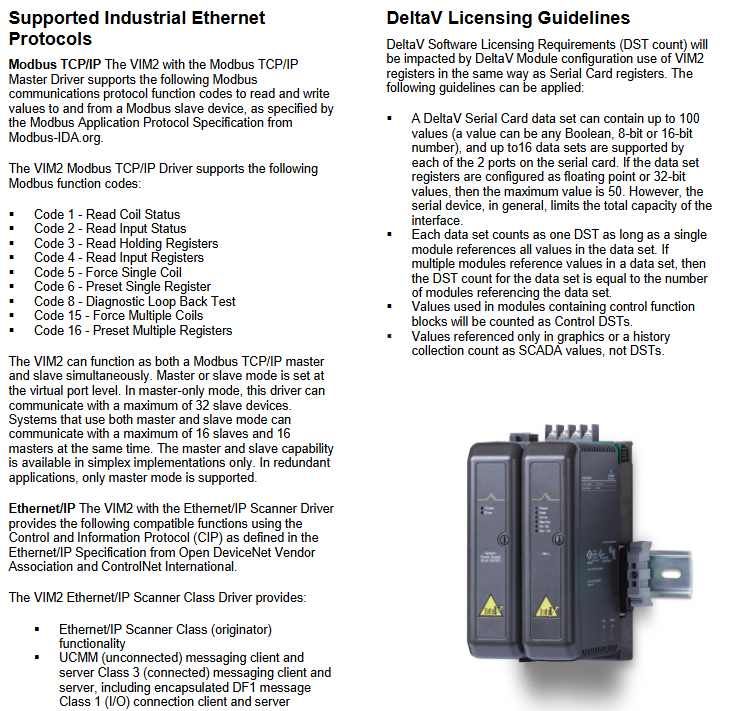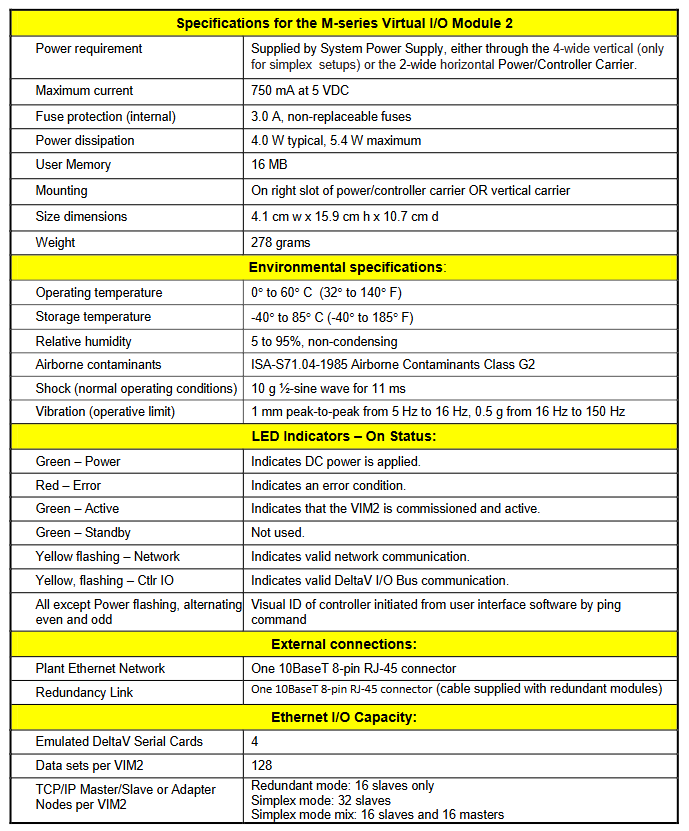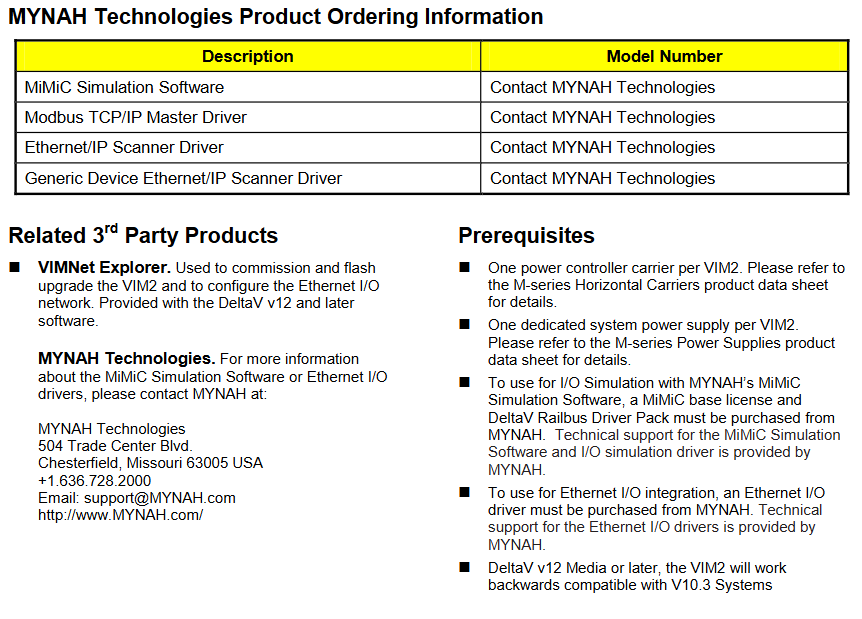

K-WANG


Emerson DeltaV M Series Virtual I/O Module 2 (VIM2)
Emerson DeltaV M Series Virtual I/O Module 2 (VIM2)
Basic Overview
The DeltaV M Series Virtual I/O Module 2 (VIM2) is an industrial grade I/O simulation and integration device launched by Emerson Process Management. It has two core functions: one is to work with MYNAH Technologies' MiMiMiC simulation software to achieve non-invasive simulation of DeltaV M Series I/O cards and digital bus field devices, supporting comprehensive testing of control strategies and system configurations; The second is to serve as an integrated platform for high-speed Ethernet I/O devices, driven by Modbus TCP/IP or Ethernet/IP protocols, to achieve signal reading and writing between the DeltaV system and devices (such as PLCs, motor control centers, weighing instruments, etc.) in the factory Ethernet I/O network. Its design is compatible with the DeltaV system architecture and can be seamlessly integrated into existing control networks.
Core advantages
(1) Non invasive DeltaV I/O simulation capability
Comprehensive simulation support: It can perform non-invasive simulation on all DeltaV M-series I/O modules (including traditional I/O, Foundation fieldbus, Profibus DP, DeviceNet, ASi bus, and serial cards) without modifying control strategies to complete DeltaV configuration testing; Simultaneously supporting simulation of all DeltaV digital buses and Foundation fieldbus function blocks, it can verify the effectiveness of fieldbus control configuration.
Efficient simulation performance: A single controller can simulate up to 64 DeltaV I/O modules, with fast and efficient simulation execution speed, which can make the DeltaV controller mistakenly believe that it is communicating with real I/O, ensuring that the test results are close to the actual operating scenario; It also supports I/O automatic detection and precise testing of controller load, providing data support for system optimization.
Supporting simulation software: It needs to be used in conjunction with MYNAH's MiMiC simulation software (software needs to be purchased separately). This software can provide dynamic simulation function for DeltaV system software acceptance testing and operator training - through simulation I/O and on-site equipment, simulate the real reaction of the process to the control system output signal, and the simulation I/O driver updates are synchronized with the MiMiC software version and can be quickly upgraded through the simulation network.
(2) Powerful Ethernet I/O integration capability
High capacity device access: A single VIM2 can simulate 4 DeltaV serial cards, supporting 128 serial card datasets for 32 network devices in single-mode configuration and 16 devices in redundant configuration. Ethernet communication is efficient and stable, meeting the large-scale equipment integration requirements of factories.
Flexible network configuration: supports user-defined IP addresses and can adapt to almost all factory network architectures (requiring the same IP subnet as Ethernet I/O devices); Simultaneously supporting 1:1 redundant configuration - by adding a second VIM2 to form a redundant pair, simulating 4 pairs of redundant DeltaV serial cards, the main and backup cards automatically switch (consistent with the switching logic of DeltaV serial cards), and the operator can obtain switching notifications through the display interface or manually control the switching in DeltaV Diagnostics.
Multi protocol compatibility: Supports two mainstream industrial Ethernet protocols and adapts to different device types:
Modbus TCP/IP: As a master, it supports 9 types of function codes, including reading coil status (Code1) and writing multiple registers (Code16). It can function as both a master and slave (up to 32 slave stations or 16 master stations+16 slave stations are supported in single-mode mode; only the master station is supported in redundant mode, up to 16 slave stations are supported).
Ethernet/IP: As a scanner (initiator), it supports CIP protocol functions such as UCMM (connectionless) messages, Class 3 (connected) messages, and Class 1 (I/O) connections, and is compatible with the Ethernet/IP specifications defined by the Open DeviceNet Vendor Association.
(3) Usability and system compatibility
Seamless DeltaV Integration: The VIM2 is recognized by the DeltaV M series controller as four DeltaV serial cards. During debugging, serial dataset configuration can be completed through the DeltaV Explorer (consistent with conventional serial card configuration). Ethernet I/O signals can be directly used for the DeltaV control module, displayed on the DeltaV Operate graphical interface, or stored in the DeltaV historical database without the need for additional interface development.
Intuitive configuration tool: Comes with the VIMNet Explorer application (integrated with DeltaV v12 and above, or provided with MYNAH driver), supports "plug and play" configuration - completes VIM2 debugging, primary and backup redundancy settings, and Ethernet I/O network parameter configuration (such as IP address, subnet mask, gateway, device node address, etc.) through graphical drag and drop operations. It also supports driver firmware upgrades and type replacements (only supports loading one Ethernet I/O driver at a time).
Modular and flexible installation: Adopting the same installation method as the DeltaV controller, it can be installed in the controller slot of a 2-wide horizontal carrier or a 4-wide vertical carrier (located on the left side of the DeltaV controller), using standard DeltaV power supply. The design is durable and can operate stably for a long time.

Details of Function Implementation
(1) Implementation of I/O simulation function
Hardware coordination: The VIM2 hardware preloads the I/O simulation driver and communicates with the MiMiC software through the simulation network. After disconnecting the real I/O card from the control system, the MiMiC driver directly writes simulation signals to the I/O subsystem of the DeltaV controller.
Simulation data management: A single simulated process controller corresponds to one MiMiC dataset, and a MiMiMiC server can support up to 32 datasets (ports). Each dataset can accommodate 4000 MiMiMiC simulation labels, meeting the requirements of large-scale process simulation.
Technical Support: Technical support for I/O simulation drivers and MiMiC software is provided by MYNAH Technologies and requires separate contact with the supplier for service.
(2) Implementation of Ethernet I/O Integration Function
Drivers and configurations: Ethernet I/O drivers (such as Modbus TCP/IP master drivers, Ethernet/IP scanner drivers, etc.) need to be purchased separately from MYNAH. After loading the drivers, the DeltaV controller can automatically detect the debugged VIM2 (serial cards identified as slots 57-60 or 61-64 in single-mode configuration, and redundant pairs identified as slots 57-64 in redundant configuration).
Redundancy mechanism: The redundant VIM2 needs to be installed on independent 2-wide carriers, equipped with independent power supplies, and monitored for the status of the main and backup devices through dedicated redundant link cables (included in the redundancy kit) - the main VIM2 continuously communicates with industrial Ethernet devices, while the backup VIM2 sends intermittent signals to maintain communication integrity and ensure uninterrupted switching between the main and backup devices.
Configuration tool requirements: VIMNet Explorer needs to run on a workstation connected to the Ethernet I/O network (which can be a DeltaV workstation with a third network card or a non DeltaV workstation), support Windows XP/7 system, and complete connection configuration through the RJ45 Ethernet interface at the bottom of VIM2.

Hardware specifications
Category specific parameters
The power requirement is supplied by the DeltaV system power supply, supporting 2-wide horizontal carriers or 4-wide vertical carriers (single-mode configuration only)
Electrical protection built-in 3.0A non replaceable fuse, maximum current 750mA (5VDC)
Typical power consumption of 4.0W, maximum value of 5.4W
Storage and Size: User Memory 16MB; Size: 4.1cm (width) x 15.9cm (height) x 10.7cm (depth), Weight: 278g
Installation method: Install in the right slot (horizontal carrier) or vertical carrier of the power/controller carrier
Environmental parameters: Operating temperature: 0 ° C~60 ° C (32 ° F~140 ° F), Storage temperature: -40 ° C~85 ° C (-40 ° F~185 ° F); Relative humidity ranging from 5% to 95% (without condensation); The air pollutant level complies with ISA-S71.04-1985 G2 level; Shock resistance (normal operation): 10g half sine wave, continuous for 11ms; Vibration resistance (working limit): 1mm peak to peak value at 5Hz~16Hz, 0.5g at 16Hz~150Hz
LED indicator light - green (power): indicates connection to DC power supply
-Red (Error): Indicates the existence of an error status
-Green (Active): indicates that VIM2 has been debugged and is in an active state
-Green (Standby): Not used
-Yellow flashing (Network): indicates normal network communication
-Yellow flashing (Ctlr IO): indicates that DeltaV I/O bus communication is normal
-Alternating flashing (parity) except for the power light: device recognition triggered by the ping command on the user interface software
External Interface - Factory Ethernet: 1 10BaseT 8-pin RJ-45 connector
-Redundant link: 1 10BaseT 8-pin RJ-45 connector (redundant kit includes dedicated cable)
Ethernet I/O Capacity - Analog DeltaV Serial Card: 4
-Number of datasets: 128 per unit
-Number of device nodes: 32 single mode slave stations (or 16 master+16 slave stations), redundant 16 slave stations
DeltaV Authorization and Configuration Rules
DST counting rule: The DeltaV software authorization requirement (DST counting) for the VIM2 register is consistent with the serial card register - a single DeltaV serial card dataset can contain up to 100 values (Boolean, 8-bit/16 bit values), and if it is a floating-point or 32-bit value, it can contain up to 50 values; If a single dataset is referenced by only one module, it is counted as one DST; If referenced by multiple modules, the DST count is equal to the number of referenced modules.
DST type differentiation: The numerical count used to control the function block is "Control DST", and the numerical count used only for graphic display or historical data acquisition is SCADA value, not included in DST count.
Ordering and matching requirements
(1) VIM2 and redundant package
M-Series Virtual I/O Module 2 (Single Mode) VE4026 Single VIM2 Device, requires separate carrier and power supply
Redundant M-series Virtual I/O Module 2 VE4027 includes 2 VIM2 devices and 1 redundant link cable
(2) Supporting products that need to be purchased separately
MiMiC simulation software MYNAH Technologies is used for I/O simulation and requires the purchase of both MiMiC basic license and DeltaV Railbus driver package
Modbus TCP/IP Master Driver MYNAH Technologies for Ethernet I/O Integration (Modbus Protocol)
Ethernet/IP scanner driver MYNAH Technologies for Ethernet I/O integration (Ethernet/IP protocol)
Universal Ethernet/IP scanner driver MYNAH Technologies adapts to non-standard Ethernet/IP devices
(3) Installation and software prerequisites
Hardware support: Each VIM2 requires one power/controller carrier (refer to the M-series horizontal carrier data sheet) and one dedicated DeltaV system power supply (refer to the M-series power supply data sheet).
Software version: Supports DeltaV v10.3 and above, and recommends using DeltaV v12 and above (VIMNet Explorer tool provided with this version of software).
Technical Support: The VIM2 hardware is supported by Emerson, while the technical support for MiMiC simulation software and Ethernet I/O drivers is provided by MYNAH Technologies

- YOKOGAWA
- Energy Access
- Renewable Integration
- Energy Subsidies
- Energy and Water
- Net zero emission
- Energy Security
- Critical Minerals
- A-B
- petroleum
- Mine scale
- Energy and Gender
- Covid-19
- man-machine
- Reliance
- ADVANCED
- SEW
- ProSoft
- WATLOW
- Kongsberg
- FANUC
- VSD
- DCS
- PLC
- Sewage treatment
- cement
- Yaskawa
- Woodward
- BOSCH Rexroth
- MOOG
- General Electric
- American NI
- Rolls-Royce
- CTI
- Honeywell
- EMERSON
- Automobile market
- xYCOM
- Motorola
- architecture
- Industrial information
- New energy
- electricity
- Construction site
- HIMA
- ABB
- Rockwell
- Schneider Modicon
- Siemens
- MAN
- GE
- TRICONEX
- Control Wave
- ALSTOM
- AMAT
- STUDER
- KONGSBERG
- MOTOROLA
- DANAHER MOTION
- Bentley
- Galil
- EATON
- MOLEX
- Triconex
- DEIF
- B&W
- ZYGO
- Aerotech
- DANFOSS
- KOLLMORGEN
- Beijer
- Endress+Hauser
- schneider
- Foxboro
- KB
- REXROTH
- YAMAHA
- Johnson
- Westinghouse
- WAGO
- TOSHIBA
- TEKTRONIX
- BENDER
- BMCM
- SMC
-
GE Hydran M2-X Enhanced Monitoring
-
ABB REG316 1mrk000809-GA Numerical Generator Protection
-
ABB RED670 1MRK004810 Line differential protection
-
GE SR750-P5-G5-S5-HI-A20-R-E Feeder protection system
-
ABB PFTL301E-1.0KN 3BSE019050R1000 PillowBlock Load cells
-
Kollmorgen S33GNNA-RNNM-00 - Brushless Servo Motor
-
Kollmorgen 6sm56-s3000-g-s3-1325 - Servo Motor
-
Kollmorgen AKM52K-CCCN2-00 - Servo Motor
-
Kollmorgen PSR3-230/75-21-202 - Power Supply
-
Kollmorgen akm24d-anc2r-00 - Servo Motor
-
Kollmorgen AKM22E-ANCNR-00 - Servo Motor
-
Kollmorgen S60300-550 - Servo Drive
-
Kollmorgen B-204-B-21 - Servomotor
-
Kollmorgen AKM21E-BNBN1-00 - Servo Motor
-
Kollmorgen TT2953-1010-B - DC Servo Motor
-
Kollmorgen pa8500 - Servo Power Supply
-
Kollmorgen BDS4A-210J-0001-207C2 - Servo Drive
-
Kollmorgen TTRB1-4234-3064-AA - DC Servo Motor
-
Kollmorgen MH-827-A-43 - Servo Motor
-
Kollmorgen AKM24D-ACBNR-OO - Servo Motor
-
Kollmorgen 00-01207-002 - Servo Disk DC Motor
-
Kollmorgen AKM21C-ANBNAB-00 - Servo Motor
-
Kollmorgen PSR3-208/50-01-003 - Power Supply
-
Kollmorgen 6SM56-S3000 - Servo Motor
-
Kollmorgen DBL3H00130-B3M-000-S40 - Servo Motor
-
Kollmorgen 6SN37L-4000 - Servo Motor
-
Kollmorgen AKM65K-ACCNR-00 - Servo motor
-
Kollmorgen 6SM56-L3000-G - Servo Motor
-
Kollmorgen AKMH43H-CCCNRE5K - Servo Motor
-
Kollmorgen PSR4/52858300 - Power Supply
-
Kollmorgen KBM-79H03-E03 - Direct Drive Rotary Motor
-
Kollmorgen AKM33E-ANCNDA00 - Servo Motor
-
Kollmorgen U9M4/9FA4T/M23 - ServoDisc DC Motor
-
Kollmorgen AKM13C-ANCNR-00 - Servo Motor
-
Kollmorgen AKM43L-ACD2CA00 - Servo Motor
-
Kollmorgen AKM54K-CCCN2-00 - Servo Motor
-
Kollmorgen M-605-B-B1-B3 - Servo Motor
-
Kollmorgen AKD-P00606-NBAN-0000 - Rotary Drive
-
Kollmorgen 6SM-37M-6.000 - Servo Motor
-
Kollmorgen A.F.031.5 - Sercos Interface Board
-
Kollmorgen 918974 5054 - Servo PWM
-
Kollmorgen U12M4 - ServoDisc DC Motor
-
Kollmorgen AKD-B00606-NBAN-0000 - Servo Drive
-
Kollmorgen MV65WKS-CE310/22PB - Servo Drive
-
Kollmorgen 65WKS-CE310/22PB - Servo Drive
-
Kollmorgen EM10-27 - Module
-
Kollmorgen S64001 - Servo Drive
-
Kollmorgen CR03200-000000 - Servo Drive
-
Kollmorgen 6SM57M-3000+G - Servo Motor
-
Kollmorgen BDS4 - Servo Drive
-
Kollmorgen AKD-P00306-NBEC-000 - Servo Drive
-
Kollmorgen AKD-B01206-NBAN-0000 - Servo Drive
-
Kollmorgen STP-57D301 - Stepper Motor
-
Kollmorgen 6SM37L-4.000 - Servo Motor
-
Kollmorgen 44-10193-001 - Circuit Board
-
Kollmorgen PRDR9SP24SHA-12 - Board
-
Kollmorgen PRD-AMPE25EA-00 - Servo Drive
-
Kollmorgen DBL3N00130-0R2-000-S40 - Servo Motor
-
Kollmorgen S406BA-SE - Servo Drive
-
Kollmorgen AKD-P00607-NBEI-0000 - Servo Drive
-
Kollmorgen AKD-P01207-NBEC-0000 - Servo Drive
-
Kollmorgen CR03550 - Servo Drive
-
Kollmorgen VSA24-0012/1804J-20-042E - Servo Drive
-
Kollmorgen N2-AKM23D-B2C-10L-5B-4-MF1-FT1E-C0 - Actuator
-
Kollmorgen 04S-M60/12-PB - Servo Drive
-
Kollmorgen H33NLHP-LNW-NS50 - Stepper Motor
-
Kollmorgen A-78771 - Interlock Board
-
Kollmorgen AKM43E-SSSSS-06 - Servo Motor
-
Kollmorgen AKD-P00607-NBEC-0000 - Servo Drive
-
Kollmorgen E21NCHT-LNN-NS-00 - Stepper Motor
-
Kollmorgen cr10704 - Servo Drive
-
Kollmorgen d101a-93-1215-001 - Motor
-
Kollmorgen BDS4A-203J-0001-EB202B21P - Servo Drive
-
Kollmorgen MCSS23-6432-002 - Connector
-
Kollmorgen AKD-P01207-NACC-D065 - Servo Drive
-
Kollmorgen CK-S200-IP-AC-TB - I/O Adapter and Connector
-
Kollmorgen CR10260 - Servo Drive
-
Kollmorgen EC3-AKM42G-C2R-70-04A-200-MP2-FC2-C0 - Actuator
-
Kollmorgen BDS5A-206-01010-205B2-030 - Servo Drive
-
Kollmorgen s2350-vts - Servo Drive
-
Kollmorgen AKM24D-ANC2DB-00 - Servo Motor
-
Kollmorgen E31NCHT-LNN-NS-01 - Stepper Motor
-
Kollmorgen PRD-0051AMPF-Y0 - Servo Board
-
Kollmorgen TB03500 - Module
-
Kollmorgen 60WKS-M240/06-PB - Servo Drive
-
Kollmorgen M21NRXC-LNN-NS-00 - Stepper Motor
-
Kollmorgen H-344H-0212 - Servo Motor
-
Kollmorgen MCSS08-3232-001 - Connector
-
Kollmorgen AKM33H-ANCNC-00 - Servo Motor
-
Kollmorgen PA-2800 - Power Supply
-
Kollmorgen MTC308C1-R1C1 - Servo Motor
-
Kollmorgen PRDR0091300Z-00 - Capacitor Board
-
Kollmorgen BDS4A-206J-0024/01502D79 - Servo Drive
-
Kollmorgen S20330-VTS - Servo Drive
-
Kollmorgen S20250-CNS - Servo Drive
-
Kollmorgen SBD2-20-1105-WO - Servo Drive Board
-
Kollmorgen M405-C-A1--E1 - Servo Motor
-
Kollmorgen PRD-PB805EDD-00 - Servo Drive
-
Kollmorgen 6SM57S-3.000-J-09-HA-IN - Servo Motor
-
Kollmorgen AKM33H-ANCNDA-00 - Servo Motor
-
Kollmorgen PCB-00030200-04 - PCB
-
Kollmorgen H22SSLB-LNN-NS-02 - Stepper Motor
-
Kollmorgen BJRL-20012-110001 - Module
-
Kollmorgen BDS4A-206J-0001404A - Servo Drive
-
Kollmorgen H-342-H-0802 - Servo Motor
-
Kollmorgen CR10561 - Servo Drive
-
Kollmorgen BDS5A-206-00010-205B2-030 - Servo Drive
-
Kollmorgen BDS5A-206-00010-207B-2-030 - Servo Drive
-
Kollmorgen mcss08-3224-001 - Connector
-
Kollmorgen M-207-B-23-B3 - Servo Motor
-
Kollmorgen PRD-0041200Z-S0 - Encoder/Resolver Card
-
Kollmorgen MH-225-G-61 - Motor
-
Kollmorgen MT308B1-T1C1 - Servo Motor
-
Kollmorgen BDS4A-240J-0001604C83 - Servo Drive
-
Kollmorgen 6SM57-S-3000 - Servo Motor
-
Kollmorgen N-T31V-15-5B-6-MF3-FT1E-C251 - Actuator
-
Kollmorgen PRD-0051AMPA-X0 - Servo Board
-
Kollmorgen CF-SS-RHGE-09 - Cable
-
Kollmorgen DIGIFAS7204 - Servo Drive
-
Kollmorgen S30101-NA - Servo Drive
-
Kollmorgen DIGIFAS7201 - Servo Drive
-
Kollmorgen PRD-0051AMPA-Y0 - Servo Board
-
Kollmorgen AKM23D-EFCNC-00 - Servo Motor
-
Kollmorgen SE10000 - Servo Drive
-
Kollmorgen PSR4/5A-112-0400 - Power Supply
-
Kollmorgen AKM31H-ANCNC-01 - Servo Motor
-
Kollmorgen M-203-B-93-027 - Servo Motor
-
Kollmorgen CP-SS-G1HE-05 - Connector




